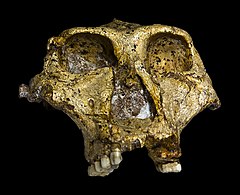Paranthropus robustus
| Paranthropus robustus | |
| Broom, 1938 | |
| Okres istnienia: 1,6 mln lat temu | |
 Czaszka Paranthropus robustus w Transvaal Museum | |
| Systematyka | |
| Domena | |
|---|---|
| Królestwo | |
| Typ | |
| Podtyp | |
| Gromada | |
| Rząd | |
| Rodzina | |
| Rodzaj | Paranthropus |
| Gatunek | Paranthropus robustus |
Paranthropus robustus (lub Australopithecus robustus) – przedstawiciel australopiteków masywnych.
Zamieszkiwał Afrykę południową około 1,6 mln lat temu. Mniej więcej w tym samym czasie w Afryce Wschodniej żył Paranthropus boisei. Ich cechą charakterystyczną były masywne kości czaszki. Australopithecus robustus należy do bocznej linii rozwojowej człowieka, która zajęła niszę ewolucyjną w związku z wysychaniem Afryki. Rasa wymarła.
Media użyte na tej stronie
Autor: (of code) -xfi-, Licencja: CC BY-SA 3.0
The Wikispecies logo created by Zephram Stark based on a concept design by Jeremykemp.
Autor: High Contrast, Licencja: CC BY 3.0 de
Anthroplogy - human skull of a boy. The skull is of a boy that was likely about 8 years old. The age of the skull itself is not known. Note the mandibular central incisors breaking through.
(c) Oryctes, CC BY-SA 3.0
Cast of the Sahelanthropus tchadensis holotype cranium TM 266-01-060-1, dubbed Toumaï, in facio-lateral view.
Autor: Thomas Roche from San Francisco, USA, Licencja: CC BY-SA 2.0
Homo erectus, Museum of Natural History, Ann Arbor, Michigan, November 2007.
Autor: Autor nie został podany w rozpoznawalny automatycznie sposób. Założono, że to Alberto Salguero (w oparciu o szablon praw autorskich)., Licencja: CC-BY-SA-3.0
Pablo Alberto Salguero Quiles
Autor: Ditsong National Museum of Natural History , Licencja: CC BY-SA 4.0
The original complete skull (without mandible) of a 1,8 million years old Paranthropus robustus (SK-48 Swartkrans (26°00'S 27°45'E), Gauteng,), discovered in South Africa . Collection of the Transvaal Museum, Northern Flagship Institute, Pretoria South Africa.







